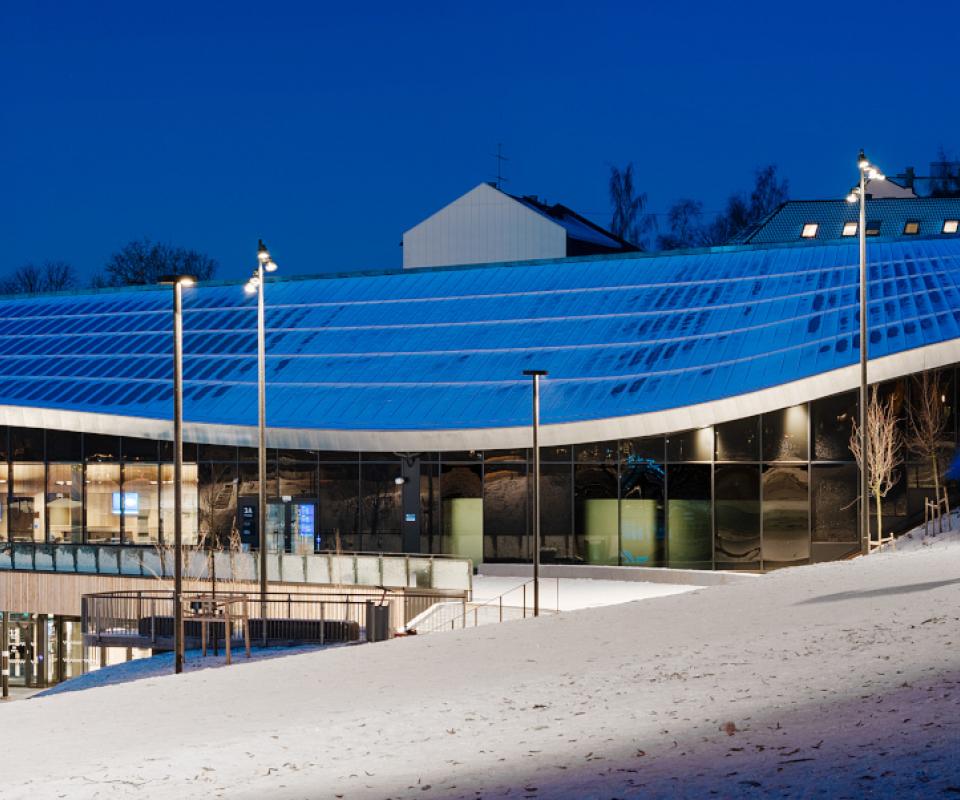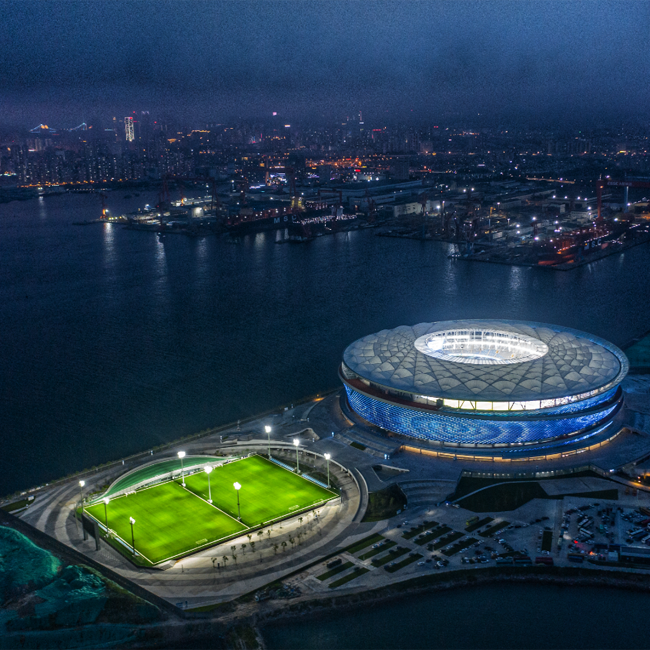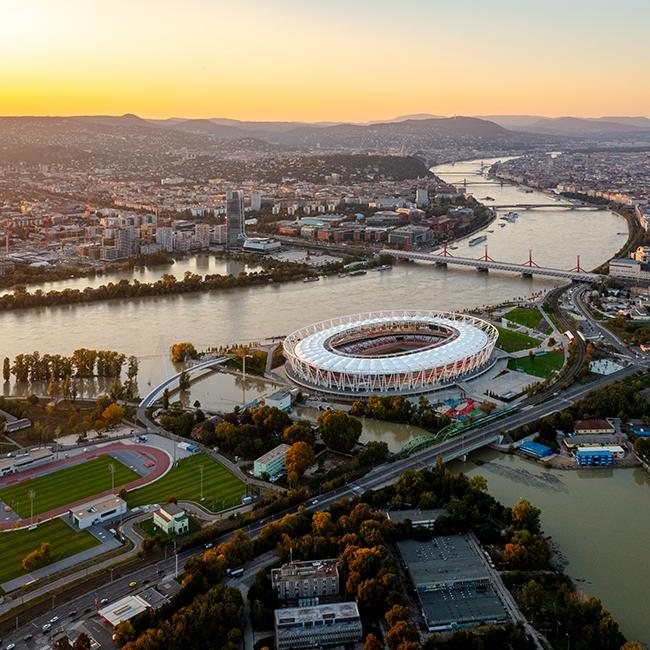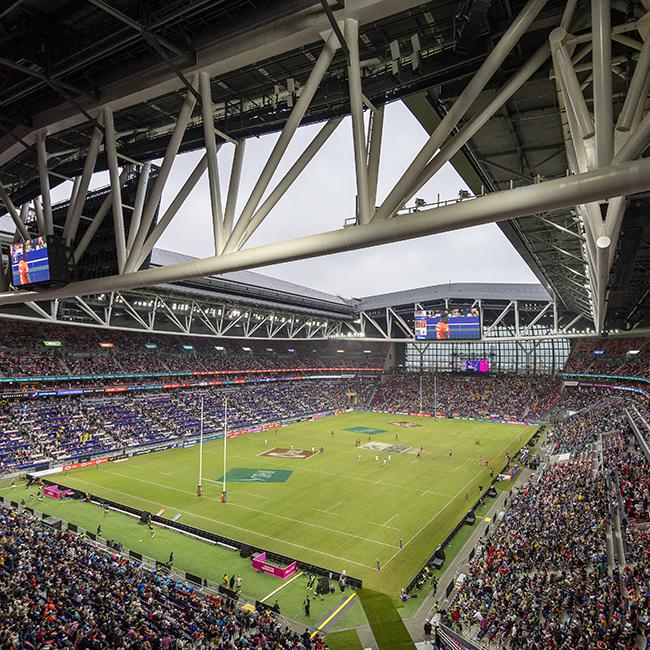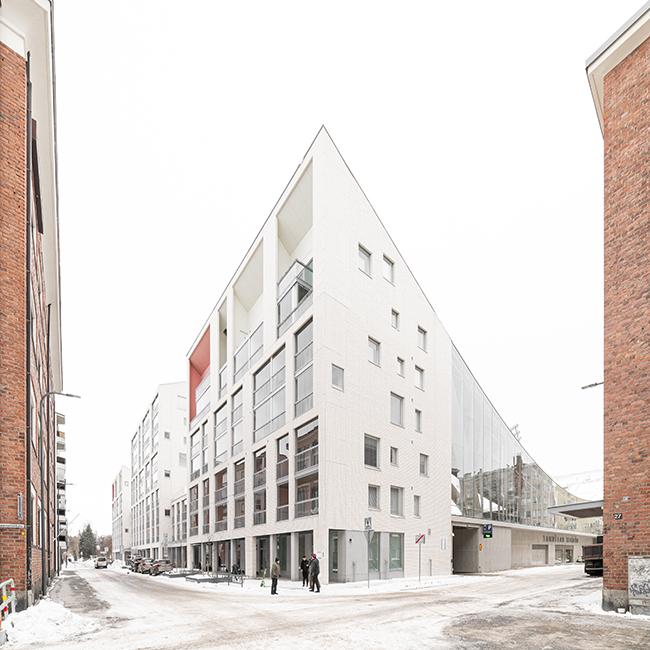published in sb 1/2021
Transparent, compact and energy-efficient
Built upon the footprint of its forerunner – the legendary Jordal Amfi – the new Jordal Amfi arena has a spectator capacity of 5,300 with a gross internal area of 14,500 m² distributed between four floors and including the stands. Hille Melbye Arkitekter have designed and optimised the arena for national and international ice hockey events, while it can also host other sports and events. The facility is located in the north-west corner of Jordal sports park in Oslo. On the base level, the arena is directly connected to an adjacent training venue for ice hockey, the Jordal Ungdomshall (youth arena).
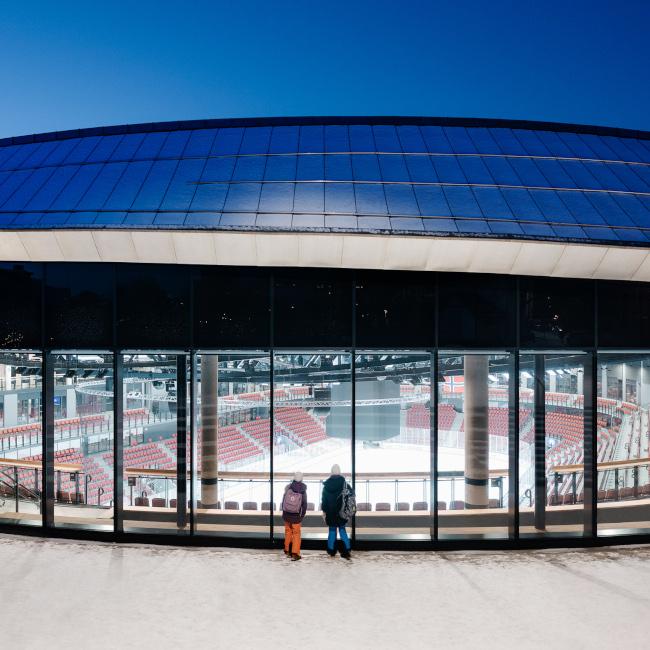
photo: Einar Aslaksen / Pudder Agency
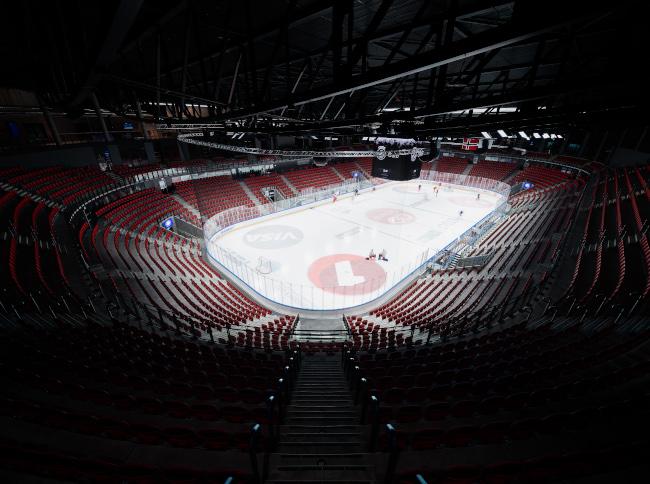
photo: Einar Aslaksen / Pudder Agency
The arena project is part of a larger transformation of Jordal sports park, including the reopening of a previously culverted river. The park is surrounded by a dense urban setting and situated just 2 kilometres east of the city centre.
The new competition venue at Jordal preserves a long and valuable tradition of ice sports in the area. The original, open-air Amfi was inspired by ancient theatres and built to host the Oslo Winter Olympics in 1952. Its dramatic intimacy, with steep and asymmetrical stands trimmed by the surrounding landscape, made it a unique and very site-specific arena. Oslo’s history lovers urged that the new arena should inherit some of the design characteristics that gave the old Amfi its legendary status.
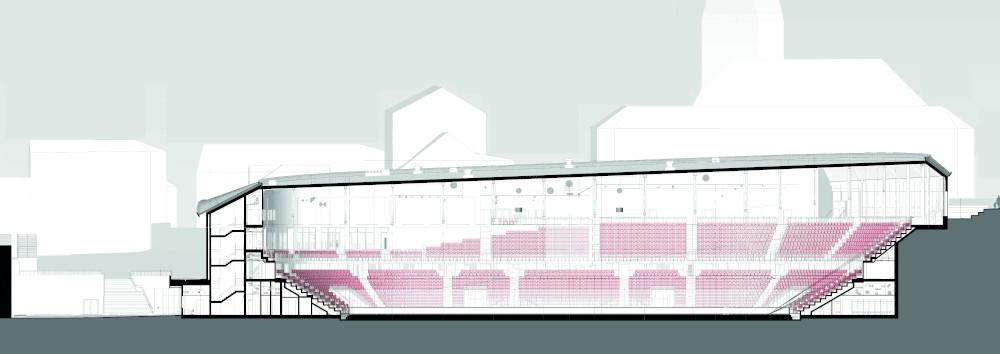
Hille Melbye Arkitekter
Good to know

photo: Einar Aslaksen / Pudder Agency
Location
Oslo, Norway
Client/operator
Kultur- og Idrettsbygg Oslo KF
Architects
Hille Melbye Arkitekter
NO – 0182 Oslo
www.hmark.no
Landscape architects
Bjørbekk & Lindheim
Ice hockey board
Vepe Oy
www.vepe.fi
Authors
Magnus Sandberg Johansen and Robin Rakke (Hille Melbye Arkitekter)
Kristina Bødal (Kultur- og Idrettsbygg Oslo KF)
Photos
Einar Aslaksen / Pudder Agency
Official opening
October 2020
Construction costs
NOK 694 million
(EUR 66.6 million)
Prefer to have your own copy? Or even better: subscribe to the sb magazine - and you receive all six issues per year
High degree of transparency
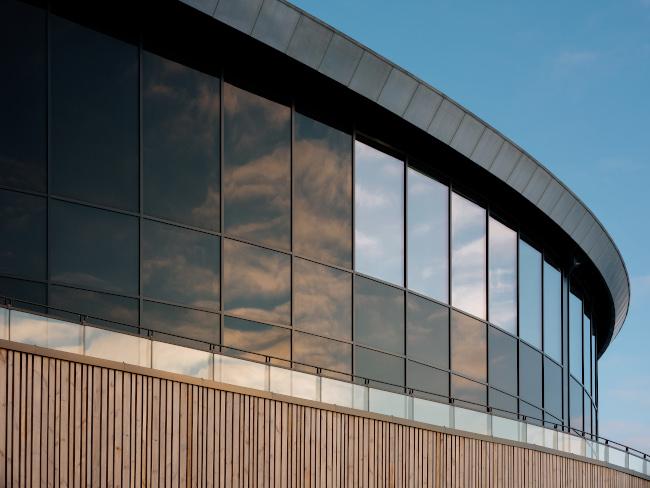
photo: Einar Aslaksen / Pudder Agency
This request boiled down to two main design rules for the new arena; an asymmetrical spectator terrace rising with the terrain and a tilted roof band gently wrapping and down-scaling the building volume. At the south end, the roof band changes direction abruptly to accommodate the roof shape above the stage building of the original Jordal Amfi.
The old Amfi, like many other arenas of the past generation, operated as an introverted black hole in its surroundings, only opening to the public for occasional events. In contrast, the new arena communicates with its surroundings by having a high grade of transparency. Everyday indoor sports activities are visible directly from the surrounding streets and park via transparent façades, hoping to inspire passers-by. Its physical interaction with the enclosing terrain creates spaces that encourage multiple user groups to engage in recreational activity.
Sloping terraces support its inviting character
These architectural steps seek to make Jordal Amfi an arena in the park, not a closed box with a park surrounding it. The elevated terrain that surrounds the complex makes the design guidelines quite different from those of most other arenas that stand on a level surface. It allows spectators to enter directly on the floor level that is above the assigned seating in the stands. On each floor, the slabs are extended beyond the outline of the façade to create entrance forecourts braiding into the sloping landscape.
The limited space of the site has made the arena space very compact and intimate. The spectator viewing area is divided in a lower and an upper stand that are levelled with the elevated terrain. The lower stand is symmetrical while the upper terrace is asymmetrical. The lateral gap between them is kept to a minimum so that the spectator mass is as concentrated as possible, which is essential for the spectator atmosphere. The concrete stand itself is curved in planar view, not faceted in straight lines, which makes all seating places more equal, no matter whether they are placed on the main stand, in the curve or at the short end. Spanning the arena space are 60 m long steel trusses with curved bottom chords. These shapes empower the dramatic bowl impression of the stands, rising upwards away from the rink.
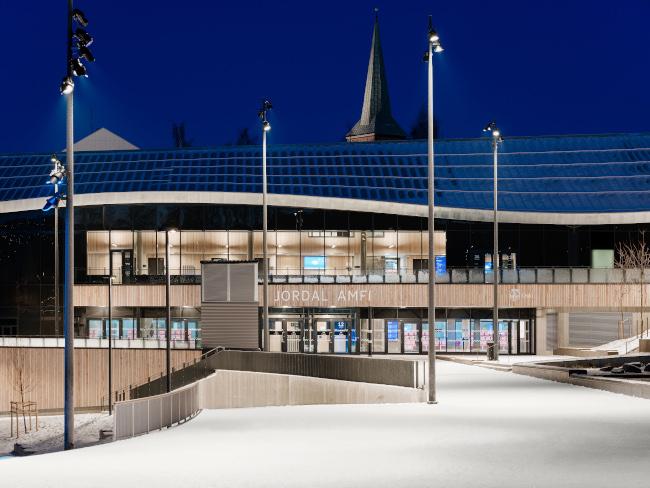
photo: Einar Aslaksen / Pudder Agency
Smart energy and ventilation system
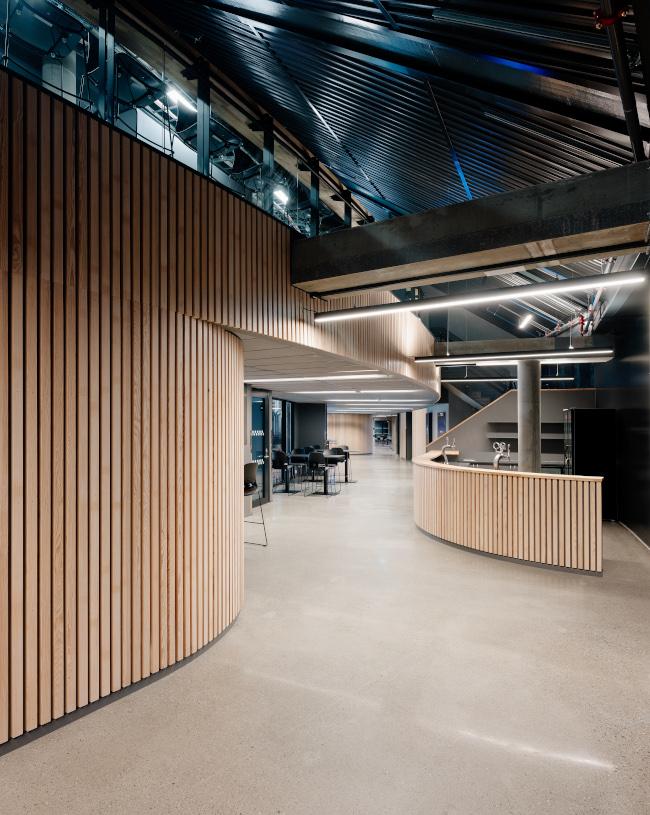
photo: Einar Aslaksen / Pudder Agency
The complex is built to passive house standard and has several solutions classifying it as a highly energy-efficient arena. Climatic zones, energy management systems, automatic sunshades, solar panels, a green roof and 30 geothermal energy wells make the arena three times more energy-efficient than its forerunner. New Jordal Amfi was one of Norway’s first fossil-free construction sites.
The thermal gain from both the refrigeration of the ice rink and heat recovered from the ventilation system are used to heat several functions in the arena. The system is connected to the adjacent training hall which increases its flexibility and energy gain. A geothermal system consisting of thirty boreholes ensures that the heat stored in summer can serve the building in winter. Thus, the arena is 95 % self-sufficient with thermal energy.
To reduce its energy consumption, the venue is divided into three main climatic zones. The arena space is separated from the surrounding warmer functions by a physical barrier with climatic properties. The open arena space itself is divided into two climatic zones; the ice rink and the surrounding viewing area. The spectator stands are ventilated via vents below each seat. Several ventilation systems can be adjusted to suit the current climatic impact and different numbers of users in the arena.
